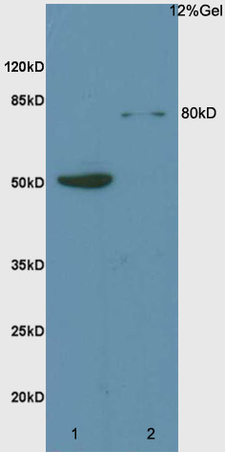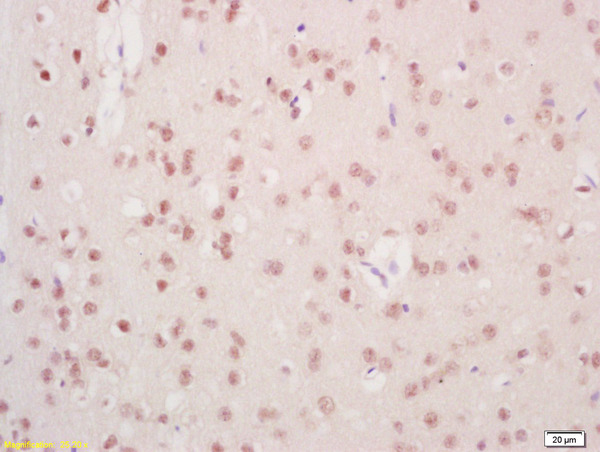Rabbit Anti-Mre11 Polyclonal Antibody
Purified Rabbit Polyclonal Antibody (Pab)
- 产品详情
- 实验流程
- 背景知识
Application
| IHC-P, IHC-F, IF, E |
|---|---|
| Primary Accession | P49959 |
| Reactivity | Human, Mouse, Rat |
| Host | Rabbit |
| Clonality | Polyclonal |
| Calculated MW | 80593 Da |
| Physical State | Liquid |
| Immunogen | KLH conjugated synthetic peptide derived from human Mre11/HNGS1 |
| Epitope Specificity | 451-550/708 |
| Isotype | IgG |
| Purity | affinity purified by Protein A |
| Buffer | 0.01M TBS (pH7.4) with 1% BSA, 0.02% Proclin300 and 50% Glycerol. |
| SUBCELLULAR LOCATION | Nucleus. Note=Localizes to discrete nuclear foci after treatment with genotoxic agents. |
| SIMILARITY | Belongs to the MRE11/RAD32 family. |
| SUBUNIT | Component of the MRN complex composed of two heterodimers RAD50/MRE11A associated with a single NBN. Component of the BASC complex, at least composed of BRCA1, MSH2, MSH6, MLH1, ATM, BLM, RAD50, MRE11A and NBN. Interacts with DCLRE1C/Artemis and DCLRE1B/Apollo. |
| Post-translational modifications | Phosphorylated upon DNA damage, probably by ATM or ATR. |
| DISEASE | Defects in MRE11A are a cause of ataxia telangiectasia-like disorder (ATLD) [MIM:604391]. ATLD is a disease with the same clinical feature than ataxia-telangiectasia but with a somewhat milder clinical course. |
| Important Note | This product as supplied is intended for research use only, not for use in human, therapeutic or diagnostic applications. |
| Background Descriptions | This gene encodes a nuclear protein involved in homologous recombination, telomere length maintenance, and DNA double-strand break repair. By itself, the protein has 3' to 5' exonuclease activity and endonuclease activity. The protein forms a complex with the RAD50 homolog; this complex is required for nonhomologous joining of DNA ends and possesses increased single-stranded DNA endonuclease and 3' to 5' exonuclease activities. In conjunction with a DNA ligase, this protein promotes the joining of noncomplementary ends in vitro using short homologies near the ends of the DNA fragments. This gene has a pseudogene on chromosome 3. Alternative splicing of this gene results in two transcript variants encoding different isoforms. [provided by RefSeq, Jul 2008] |
| Gene ID | 4361 |
|---|---|
| Other Names | ATLD; HNGS1; MRE11; MRE11B; Double-strand break repair protein MRE11A; Meiotic recombination 11 homolog 1; MRE11 homolog 1; Meiotic recombination 11 homolog A; MRE11 homolog A; MRE11A |
| Dilution | IHC-P=1:100-500,IHC-F=1:100-500,IF=1:100-500,ELISA=1:5000-10000 |
| Format | 0.01M TBS(pH7.4) with 1% BSA, 0.09% (W/V) sodium azide and 50% Glyce |
| Storage | Store at -20 °C for one year. Avoid repeated freeze/thaw cycles. When reconstituted in sterile pH 7.4 0.01M PBS or diluent of antibody the antibody is stable for at least two weeks at 2-4 °C. |
| Name | MRE11 {ECO:0000303|PubMed:8530104, ECO:0000312|HGNC:HGNC:7230} |
|---|---|
| Function | Core component of the MRN complex, which plays a central role in double-strand break (DSB) repair, DNA recombination, maintenance of telomere integrity and meiosis (PubMed:11741547, PubMed:14657032, PubMed:22078559, PubMed:23080121, PubMed:24316220, PubMed:26240375, PubMed:27889449, PubMed:28867292, PubMed:29670289, PubMed:30464262, PubMed:30612738, PubMed:31353207, PubMed:37696958, PubMed:38128537, PubMed:9590181, PubMed:9651580, PubMed:9705271). The MRN complex is involved in the repair of DNA double-strand breaks (DSBs) via homologous recombination (HR), an error-free mechanism which primarily occurs during S and G2 phases (PubMed:24316220, PubMed:28867292, PubMed:31353207, PubMed:38128537). The complex (1) mediates the end resection of damaged DNA, which generates proper single-stranded DNA, a key initial steps in HR, and is (2) required for the recruitment of other repair factors and efficient activation of ATM and ATR upon DNA damage (PubMed:24316220, PubMed:27889449, PubMed:28867292, PubMed:36050397, PubMed:38128537). Within the MRN complex, MRE11 possesses both single-strand endonuclease activity and double-strand- specific 3'-5' exonuclease activity (PubMed:11741547, PubMed:22078559, PubMed:24316220, PubMed:26240375, PubMed:27889449, PubMed:29670289, PubMed:31353207, PubMed:36563124, PubMed:9590181, PubMed:9651580, PubMed:9705271). After DSBs, MRE11 is loaded onto DSBs sites and cleaves DNA by cooperating with RBBP8/CtIP to initiate end resection (PubMed:27814491, PubMed:27889449, PubMed:30787182). MRE11 first endonucleolytically cleaves the 5' strand at DNA DSB ends to prevent non-homologous end joining (NHEJ) and licence HR (PubMed:24316220). It then generates a single-stranded DNA gap via 3' to 5' exonucleolytic degradation to create entry sites for EXO1- and DNA2-mediated 5' to 3' long-range resection, which is required for single-strand invasion and recombination (PubMed:24316220, PubMed:28867292). RBBP8/CtIP specifically promotes the endonuclease activity of MRE11 to clear protein-DNA adducts and generate clean double-strand break ends (PubMed:27814491, PubMed:27889449, PubMed:30787182). MRE11 endonuclease activity is also enhanced by AGER/RAGE (By similarity). The MRN complex is also required for DNA damage signaling via activation of the ATM and ATR kinases: the nuclease activity of MRE11 is not required to activate ATM and ATR (PubMed:14657032, PubMed:15064416, PubMed:15790808, PubMed:16622404). The MRN complex is also required for the processing of R-loops (PubMed:31537797). The MRN complex is involved in the activation of the cGAS-STING pathway induced by DNA damage during tumorigenesis: the MRN complex acts by displacing CGAS from nucleosome sequestration, thereby activating it (By similarity). In telomeres the MRN complex may modulate t-loop formation (PubMed:10888888). |
| Cellular Location | Nucleus. Chromosome. Chromosome, telomere Note=Localizes to DNA double-strand breaks (DSBs) |
For Research Use Only. Not For Use In Diagnostic Procedures.
Provided below are standard protocols that you may find useful for product applications.
BACKGROUND
Component of the MRN complex, which plays a central role in double-strand break (DSB) repair, DNA recombination, maintenance of telomere integrity and meiosis. The complex possesses single-strand endonuclease activity and double-strand- specific 3'-5' exonuclease activity, which are provided by MRE11A. RAD50 may be required to bind DNA ends and hold them in close proximity. This could facilitate searches for short or long regions of sequence homology in the recombining DNA templates, and may also stimulate the activity of DNA ligases and/or restrict the nuclease activity of MRE11A to prevent nucleolytic degradation past a given point. The complex may also be required for DNA damage signaling via activation of the ATM kinase. In telomeres the MRN complex may modulate t-loop formation.
REFERENCES
Petrini J.H.J.,et al.Genomics 29:80-86(1995).
Petrini J.H.J.,et al.Submitted (NOV-1998) to the EMBL/GenBank/DDBJ databases.
Chamankhah M.,et al.Submitted (SEP-1997) to the EMBL/GenBank/DDBJ databases.
Paull T.T.,et al.Mol. Cell 1:969-979(1998).
Pitts S.A.,et al.Hum. Mol. Genet. 10:1155-1162(2001).
终于等到您。ABCEPTA(百远生物)抗体产品。
点击下方“我要评价 ”按钮提交您的反馈信息,您的反馈和评价是我们最宝贵的财富之一,
我们将在1-3个工作日内处理您的反馈信息。
如有疑问,联系:0512-88856768 tech-china@abcepta.com.























 癌症的基本特征包括细胞增殖、血管生成、迁移、凋亡逃避机制和细胞永生等。找到癌症发生过程中这些通路的关键标记物和对应的抗体用于检测至关重要。
癌症的基本特征包括细胞增殖、血管生成、迁移、凋亡逃避机制和细胞永生等。找到癌症发生过程中这些通路的关键标记物和对应的抗体用于检测至关重要。 为您推荐一个泛素化位点预测神器——泛素化分析工具,可以为您的蛋白的泛素化位点作出预测和评分。
为您推荐一个泛素化位点预测神器——泛素化分析工具,可以为您的蛋白的泛素化位点作出预测和评分。 细胞自噬受体图形绘图工具为你的蛋白的细胞受体结合位点作出预测和评分,识别结合到自噬通路中的蛋白是非常重要的,便于让我们理解自噬在正常生理、病理过程中的作用,如发育、细胞分化、神经退化性疾病、压力条件下、感染和癌症。
细胞自噬受体图形绘图工具为你的蛋白的细胞受体结合位点作出预测和评分,识别结合到自噬通路中的蛋白是非常重要的,便于让我们理解自噬在正常生理、病理过程中的作用,如发育、细胞分化、神经退化性疾病、压力条件下、感染和癌症。







